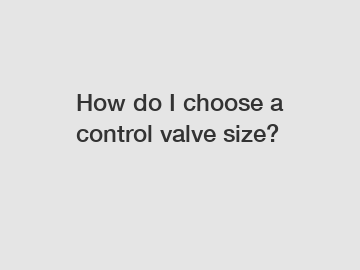How do I choose a control valve size?
How do I choose a control valve size?
Control valves are an essential component of many industrial processes, as they help regulate the flow of fluids or gases through a pipeline. Selecting the right control valve size is crucial to ensure efficient and effective operation, as using an improperly sized valve can lead to performance issues and increased maintenance requirements. With numerous factors to consider, choosing the correct size can be a complex task. In this article, we will discuss some key considerations that can help you determine the appropriate control valve size for your application.
Process Flow Rate.

The flow rate of the fluid or gas passing through the control valve is one of the primary factors to consider when choosing the valve size. Determining the required flow rate will depend on the specific application and process requirements. It is essential to carefully evaluate the flow characteristics, including the maximum and minimum flow rates, as well as the normal operating flow rate. Additionally, consider the potential for future expansions or changes in the process that may affect the flow rates. Accurate calculations and estimations are vital to select a control valve size that can handle the required flow rates without significant pressure drops or flow restrictions.
Pressure Drop.
Another critical factor to consider is the pressure drop across the control valve. The pressure drop is the difference between the pressure on the inlet side and the pressure on the outlet side of the valve. It is essential to select a control valve size that ensures an acceptable pressure drop across the valve. Excessive pressure drop can lead to decreased flow rates, increased energy consumption, and potential damage to the valve or the piping system. Conversely, insufficient pressure drop can result in unstable operation or cavitation. Proper sizing, considering the process conditions and desired pressure drop, is crucial to ensure optimal valve performance.
Fluid Characteristics.
The characteristics of the fluid or gas passing through the control valve are also important considerations when choosing the valve size. Factors such as viscosity, density, and temperature can significantly impact the valve's performance. Different fluids may require different valve sizing criteria due to variations in their physical properties. Understanding the fluid's specific characteristics and their potential impact on the control valve is key to selecting the proper valve size for optimal operation.
Valve Sizing Methods.
Several sizing methods and equations are available to determine the appropriate control valve size. These methods take into account factors such as flow rate, pressure drop, and fluid properties to calculate the optimal valve size. Commonly used methods include the Fisher equation, the ISA-S75.01 equation, and the Cv sizing equation. Consulting with valve manufacturers or industry experts can help you navigate these methods and select the most suitable sizing approach for your specific application.
Conclusion.
Choosing the right control valve size is essential for achieving optimal system performance and efficiency. Considerations such as process flow rate, pressure drop, fluid characteristics, and appropriate sizing methods will guide you in determining the most suitable valve size for your application. Consulting with experienced professionals in the field can provide valuable insights and ensure the selection of the correct valve size for your specific needs. If you require further assistance or have any questions, please do not hesitate to contact us.
Note: Please ensure that the phrase "contact us" is included in the closing paragraph and that the subheadings are removed after the H2 headers.
The company is the world’s best proportional solenoid valve for sale, Electro Hydraulic Directional Valve Factory, stacked hydraulic control check valve supplier supplier. We are your one-stop shop for all needs. Our staff are highly-specialized and will help you find the product you need.


